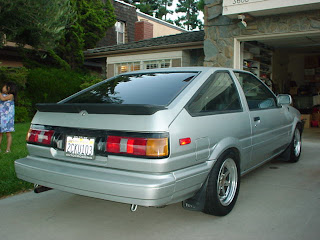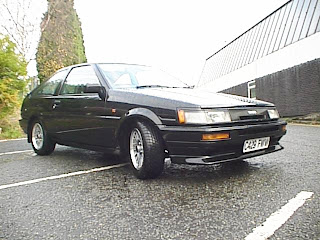The history of the AE86 dates back to 1983 when it was released on the Japanese Domestic Market. Although new sales weren't amazing, the AE86 has developed a huge international following both in the street and racing scenes. In this section I will show the variations of the AE86, expain it's history and why it is still a popular car toady.
The AE86 was first produced in 1983 in Japan and this continued until half way through 1987. During this time there were two distinct versions produced, the zenki and the kouki. These two versions can be distinguished by their front indicators and their rear lights. The zenki has small front mounted indicators and rear lights with the word 'SPRINTER' across the top of the right light. The kouki has larger corner mounted front indicators and rear lights with either a red band across the top or a black band with a white stripe.
The AE86 was available in two body types, these were the coupe and the hatchback. The hatchback is the frame most enthusiasts think of when discussing the AE86.
To further broaden the purchasers choice when buying an AE86 there were two more variations on the AE86. These were the Sprinter Trueno and the Corolla Levin. These are still available today from Toyota as they have carried through the range up to present day in the form of the AE111. The key differences in the Trueno and Levin are in their light assembly. The Trueno was given pop-up head lights unique to the AE86 and the Levin was given fixed head lights very similar to those of the rest of the Corolla range of that era. Because of this set up the Levin had a larger grill between the lights than the Trueno, in later years the Trueno grill was phased out completely and the bonnet was simply extended between the lights.
In 1984 the 4A-GE was introduced as the replacement for Toyotas respected 2T-G engine. The 2T-G had a reputation as being a strong reliable engine and many people were initially scared of the fragile appearance of the 4A-GE. With 4 valves per cylinder, Toyota had to be careful with their construction methods as this new configuration did not allow for a design as visually robust as the 2T-G. This is because the head had to make way for 2 extra valves per cylinder and the engine as a whole needed to allow for high revolutions. Toyota improved its metallurgy to resolve these issues. For specifications of the AE86 4A-GE.
Although the AE86 is now 18 years old it is experiencing a resurgence in popularity. There are three major factors contributing to this, firstly a Japanese cartoon called Initial D, secondly a form of Japanese motorsport known as drifting, and thirdly a lack of affordable, small rear wheel drive cars on the used car market.
In Initial D a young Japanese man who drives an AE86 engages in street racing with many of the most respected cars in the world today such as the Nissan Skyline GTR and the Mazda RX7. The series emphasizes the importance of driving ability and shows that expensive and powerful cars are useless without a skilled driver.
Drifting is a popular Japanese motorsport that involves inducing over-steer, usually in a rear wheel driven vehicle. This results in loss of traction in the rear wheels and the idea is to maintain this throughout the corner. Competition in Japan are rated on things such as drift style and ensuring the vehicle is drifted where ever possible. Drifting can be a graceful sport when executed properly but very expensive when things go wrong... and they usually do.
Finally, the most significant reason for me buying my AE86 was this. The AE86 was one of the last, if not the last, cheap rear wheel drive light light sports cars. After production of the AE86 ceased in 1987 there was very little choice for anyone wanting a similar car, most manufacturers, including Toyota switched to a front wheel drive format. The advantage of front wheel drive is that they generally weigh less, have more cabin space due to having no transmission tunnel, and are often thought of as safer for the average driver to handle. As most performance car enthusiasts know, if you open the throttle to much in a powerful rear wheel drive on a corner the consequences are usually much worse than doing the same in a powerful front wheel driven vehicle.
Because of the reasons above the AE86 has become a very collectable car and has a price to match. If you are lucky enough to find one to purchase. All that for an 18 year old car.... there must be something to it.




No comments:
Post a Comment